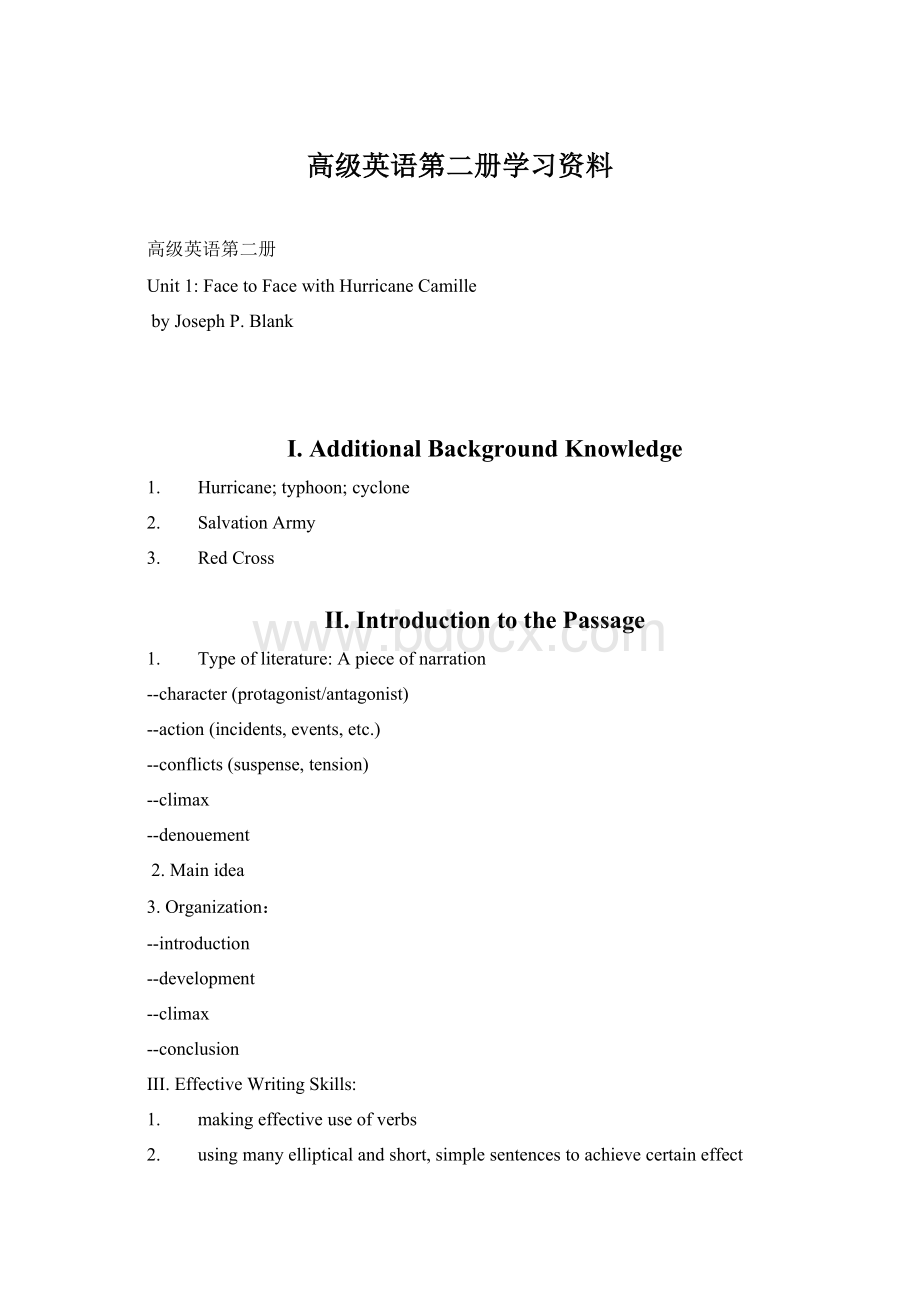 高级英语第二册学习资料.docx
高级英语第二册学习资料.docx
- 文档编号:8456105
- 上传时间:2023-01-31
- 格式:DOCX
- 页数:12
- 大小:19.46KB
高级英语第二册学习资料.docx
《高级英语第二册学习资料.docx》由会员分享,可在线阅读,更多相关《高级英语第二册学习资料.docx(12页珍藏版)》请在冰豆网上搜索。

高级英语第二册学习资料
高级英语第二册
Unit1:
FacetoFacewithHurricaneCamille
byJosephP.Blank
I.AdditionalBackgroundKnowledge
1. Hurricane;typhoon;cyclone
2. SalvationArmy
3. RedCross
II.IntroductiontothePassage
1. Typeofliterature:
Apieceofnarration
--character(protagonist/antagonist)
--action(incidents,events,etc.)
--conflicts(suspense,tension)
--climax
--denouement
2.Mainidea
3.Organization:
--introduction
--development
--climax
--conclusion
III.EffectiveWritingSkills:
1. makingeffectiveuseofverbs
2. usingmanyellipticalandshort,simplesentencestoachievecertaineffect
IV.RhetoricalDevices:
1. transferredepithet
2. personification
3. metaphor
4. simile
V.SpecialDifficulties
Avoidingthefollowingkindsofmistakes:
1. run-onsentences
2. sentencefragments
3. danglingmodifiers
4. illogicalorfaultyparallelism
5. unnecessaryshiftsinpointofview
6. paraphrasingsomesentences
7. identifyingfiguresofspeech
VI.Questions
1. Whatistheorganizationalpatternofthispieceofnarration?
2. Whatdoesthewriterfocuschieflyon---developingcharacter,action(plot),oridea(theme)?
3. Whoistheprotagonistinthestory?
4. Howdoesthewriterbuildupandsustainthesuspenseinthestory?
5. WhydidJohnKoshakfeelacrushingguilt?
Unit2:
MarrakechbyGeorgeOrwell
I.AdditionalBackgroundKnowledge
1. GeorgeOrwell
2. Morocco
3. Marrakech
4. TheJewishpeople
II.IntroductiontothePassage
1. Typeofliterature:
apieceofexposition
2. Thepurposeofapieceofexposition:
--toinformorexplain
3. Waysofdevelopingthethesisofapieceofexposition:
--comparision,contrast,analogy,identification,illustration,analysis,definition,etc.
4. Thecentralthoughtorthesis
III.EffectiveWritingSkills:
1. makingeffectiveuseofspecificverbs
2. usingthemethodsofcontrast,illustration,comparision,etc.
3. cleverchoiceofwordsandscenesandtenses
IV.RhetoricalDevices:
1. rhetoricalquestions
2. repetition
3. metaphor
4. simile
5. ellipticalsentences
V.SpecialDifficulties
1. Makingsentencesmorecompactbypropersubordination,suchassubordinateclauses,appositives,prepositionalorverbalphrases.
2. Discriminatinggroupsofsynonyms:
--wail,cry,weep,sob,whimper,moan
--glisten,glitter,flash,shimmer,sparkle
3. Paraphrasingsomesentences
4. Identifyingfiguresofspeech
VI.Questions
1. Orwellshowsthepovertyofthenativesinatleastfiveways.Identifythem.
2. Couldparagraphs4-7justaswellcomeafter8-15asbefore?
Whyorwhynot?
3. Doesthisessaygivereadersanewinsightintoimperialism?
4. CommentonOrwell’slucidstyleandfineattentiontosignificantdescriptivedetails.
Unit3:
PubTalkandKing’sEnglish
byHenryFairlie
I.AdditionalBackgroundKnowledge
1. pub/pub-friends
2. Dumas/ThreeMusketeers
3. Carlyle
4. CharlesLamb
II.IntroductiontothePassage
1. Typeofliterature:
apieceofexposition
2. Thethesis
3. Whatmakesagoodconversation
4. Seeminglylooseorganization
a. titleb.transitionalparagraphc.digression
5. Highlyinformallanguage
a.abundanceofsimpleidiomaticexpressionscheekedbyjowlwithcopiousliteraryandhistoricalallusions
b.amixedmetaphorinparagraph2
III.EffectiveWritingSkills:
1. deliberatelywritingthisessayinaconversationalstyletosuitthetheme
2. makingeffectiveuseofspecificverbs
IV.RhetoricalDevices:
1. metaphor
2. mixedmetaphor
3. simile
V.SpecialDifficulties
1.Idiomaticexpressions:
--beontherocks
--getuponthewrongsideofthebed
--beonwings
--turnupone’snoseatsth.
--intotheshoesof
2.Allusions
--descendantsofconvicts
--Saxonchurls
--Normanconquerors
--musketeersofDumas
3.Theuseoftransitionaldevices
--transitionalwordsandexpressions
--pronounreference
--repetitionofimportantwords
4.Paraphrasingsomesentences
5.Identifyingfiguresofspeech
VI.Questions
1. What,accordingtotheauthor,makesagoodconversation?
Whatspoilsit?
2. Whatistheauthor’sattitudeofthewritertowards“theKing’sEnglish”?
3. Howdoestheuseofwordsshowclassdistinction?
4. Whatdoesthewritermeanwhenhesays,“theKing’sEnglish,liketheAnglo-FrenchoftheNormans,isaclassrepresentationofreality”?
Unit4:
InauguralAddress
byJohnF.Kennedy
I.AdditionalBackgroundKnowledge
1. JohnFKennedy
2. Hisassasination
3. Inauguration
4. Inauguraladdress
5. Coldwarperiod:
socialistcampvs.capitalistcamp
II.IntroductiontothePassage
1. Typeofliterature:
politicalspeech
2. Objectofapoliticalspeech:
--toexplain
--toconvince
--topersuade
3. Wellorganizedandhighlyrhetorical
4. Biblicalstyle/language
5. Often-quotedpassages
III.EffectiveWritingSkills:
1. Employingsuitablerhetoricaldevicesandwordstocreatethedesiredemotionalimpact
2. clearorderandappropriatetonetothedifferentgroupsheisaddressing
3. EmployingBiblicalstyledeliberately
IV.RhetoricalDevices:
1. metaphor
2. antithesis
3. parallelism
4. repetition
V.SpecialDifficulties
1.Biblicallanguage/quotations/style
2.Usingthefollowingmethodsforforce,vividnessandemotionalappeal:
--Parallelandbalancedstructure
--Repetitionofimportantwords
--Antithesis
3.Paraphrasingsomesentences
4.Identifyingfiguresofspeech
VI.Questions
1. CiteexamplestoshowthatKennedyisveryparticularandcarefulinhischoiceanduseofwords.
2. Istheaddresswellorganized?
Commentontheorderinwhichheaddressedallthedifferentgroupsofnationsandpeople.
3. IsKennedy’sargumentandpersuasionbasedmainlyonfactsandlogicoronanappealtoemotions?
Wouldthistypeofspeechbesuccessfulonalloccasions?
4. Isthetoneandmessagesuitedtothedifferentgroupsheaddresses?
Giveyourreasons.
Unit5:
LoveIsaFallacy
byMaxShulman
I.AdditionalBackgroundKnowledge
1. ThemeaningofLogicalfallacies
2. Logicalfallacies:
--DictoSimpliciter
--HastyGeneralization
--PoisoningtheWell
--AdMisericordiam
II.IntroductiontothePassage
1. Typeofliterature:
apieceofnarrativewriting
--protagonist/antagonists
--climax
--denouement
2. Themaintheme
3. Wellchosentitleandwords
4. Style
--averyfastpacewitharacydialoguefullofAmericancolloquialismandslang
--employingavarietyofwritingtechniquestomakethestoryvivid,dramaticandcolorful
III.EffectiveWritingSkills:
1. Employingcolorfullexicalspectrum,fromtheultralearnedtermstotheinfraclippedvulgarforms
2. Toomuchfigurativelanguageandungrammaticalinversionforspecificpurposes
3. Theusingofshortsentences,ellipticalsentencesanddashestomaintainthespeedofnarration
IV.RhetoricalDevices:
1.metaphor
3. antithesis
4. transferredepithet
4. hyperbole
5. metonymy
6. litotes
7. ellipsis
8. synecdoche
9. inversion
10. simile
11. mixedmetaphor
12. rhetoricalquestions
V.SpecialDifficulties
1. Analyzingthelogicalfallacies
2. Usinginvertedsentencestoachieveemphasis
3.Effectivelyusingmanyfiguresofspeech
4.Understandingcolloquialexpressionsandslang
5.Allusions:
--Frankenstein
--Pygmalion
6.Paraphrasingsomesentences
7.Identifyingfiguresofspeech
VI.Questions
1. Defineandgiveanexampleofeachofthelogicalfallaciesdiscussedinthisessay.
2. Canyoufindanyevidencetosupporttheviewthatthewriterissatirizingabrightbutself-satisfiedyoungman?
3. CommentonthelanguageusedbyPolly.Whateffectdoesherlanguagecreate?
4. WhydoesthewriterrefertoPygmalionandFrankenstein?
Aretheseallusionsaptlychosen?
5. Inwhatsenseistheconclusionironic?
Unit6:
DisappearingThroughtheSkylight
ByOsborneBennetHardisonJr.
I.AdditionalBackgroundKnowledge
1. AbriefintroductiontoO.B.HardisonJr.
2. AbriefintroductiontohisviewsinCultureandTechnologyintheTwentiethCentury
3. Internationalstyle
4. FeaturesofscientificEnglish
II.IntroductiontothePassage
1. Thecentralthemeof“disappearance”
--naturedisappears
--historydisappears
--solidbanksdisappears
2.Thefourimportantideasputforward
--disappearance
--theuniversalizingtendencyofscienceandtechnology
--manasacosmopolitan
--theplayfulnessofscience
3.Clearlyandlogicallyorganized
III.TheStylisticFeatures
1. FeaturesofscientificEnglish
--technicaltermssuchasthermodynamics,genetics,geneticmutation,etc.
--shortsentencesandpresenttenseusedtoexpressauniversalstatement
2.Usingfigurativelanguagefreelytomakeideasmorevividandforceful
IV.RhetoricalDevices:
1.metaphor
2. analogies
3. repetition
4. balancedstructures
5. ellipsis
6. rhetoricalquestions
V.SpecialDifficulties
1. Sometechnicalterms
2. Understandingthemetaphoricalphrase“DisappearingThroughtheSkylight”
3. Theuseoftopicsentences
4. Theuseofpres
- 配套讲稿:
如PPT文件的首页显示word图标,表示该PPT已包含配套word讲稿。双击word图标可打开word文档。
- 特殊限制:
部分文档作品中含有的国旗、国徽等图片,仅作为作品整体效果示例展示,禁止商用。设计者仅对作品中独创性部分享有著作权。
- 关 键 词:
- 高级 英语 第二 学习 资料
 冰豆网所有资源均是用户自行上传分享,仅供网友学习交流,未经上传用户书面授权,请勿作他用。
冰豆网所有资源均是用户自行上传分享,仅供网友学习交流,未经上传用户书面授权,请勿作他用。


 对中国城市家庭的教育投资行为的理论和实证研究.docx
对中国城市家庭的教育投资行为的理论和实证研究.docx
 第二讲:人的社会化与社会角色PPT文档格式.pptx
第二讲:人的社会化与社会角色PPT文档格式.pptx
